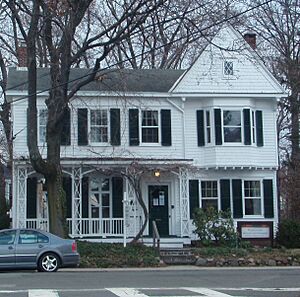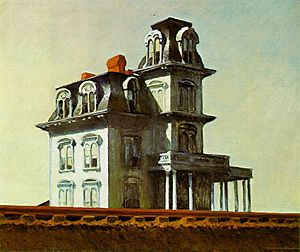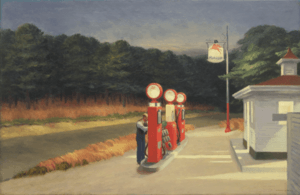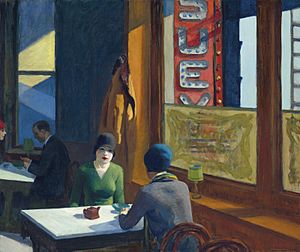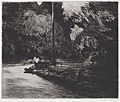Edward Hopper facts for kids
Quick facts for kids
Edward Hopper
|
|
|---|---|
 |
|
| Born | July 22, 1882 Nyack, New York, United States
|
| Died | May 15, 1967 (aged 84) Manhattan, New York, United States
|
| Nationality | American |
| Known for | Painting |
|
Notable work
|
Automat (1927) Chop Suey (1929) Nighthawks (1942) Office in a Small City (1953) |
| Spouse(s) | |
Edward Hopper (July 22, 1882 – May 15, 1967) was a famous American painter and printmaker. He is best known for his realistic paintings that often show feelings of loneliness in modern American life. While he is most famous for his oil paintings, he also worked with watercolors and made prints using etching.
Contents
Hopper's Early Life and Art
Edward Hopper was born in 1882 in Nyack, New York. This town was a center for building yachts on the Hudson River, just north of New York City. He grew up in a comfortable family with one sister, Marion. His parents, Elizabeth Griffiths Smith and Garret Henry Hopper, supported his interest in art. They made sure he had plenty of art supplies, magazines, and books.
Edward's childhood home is now a museum called the Edward Hopper House Museum & Study Center. It is a cultural center that features art shows, workshops, and special events.
Edward was a good student, and by age five, his talent for drawing was clear. He started signing and dating his drawings when he was 10 years old. Even in these early works, you can see how much attention he paid to light and shadow. This focus on light became a big part of his art throughout his life.
As a teenager, he worked with pen-and-ink, charcoal, watercolor, and oil paints. He drew from nature and even made political cartoons. In 1895, he created his first oil painting, Rowboat in Rocky Cove. He copied this from an art magazine.
When he was in high school, Edward thought about becoming a naval architect. But after graduating in 1899, he decided to become an artist instead. His parents wanted him to study commercial art so he would have a steady job. Edward was influenced by the writer Ralph Waldo Emerson, saying, "I admire him greatly...I read him over and over again."
Edward began studying art in 1899. He later went to the New York School of Art and Design, which is now Parsons School of Design. He studied there for six years. One of his teachers was William Merritt Chase, who taught him oil painting. Another important teacher was Robert Henri. Henri encouraged his students to paint realistic scenes of city life. Many of Henri's students became important artists and were known as the Ashcan School of American art.
Hopper's Art Career
After finishing his art studies, Hopper traveled to Europe three times. He wanted to learn about the new modern art styles there. Unlike many artists who were trying out abstract styles like Cubism, Hopper was drawn to the realist painters. Realism focuses on showing things as they truly are. His early works show this realist influence.
For several years, Hopper worked as a commercial artist, but he kept painting in his free time. In 1925, he created House by the Railroad. This painting is considered a very important work and shows his unique artistic style. It was the first of many paintings that showed stark (simple and plain) city and country scenes. He used sharp lines and large shapes, with unusual lighting, to capture a lonely feeling in his subjects.
Hopper found his subjects in everyday American life. He painted gas stations, motels, railroads, or empty streets. He was very busy in the 1930s and early 1940s. During this time, he painted many famous works, including New York Movie (1939), Girlie Show (1941), Nighthawks (1942), Hotel Lobby (1943), and Morning in a City (1944).
In the late 1940s, he painted less often. He said, "I wish I could paint more. I get sick of reading and going to the movies." His health became weaker in the next two decades, and he had several surgeries. But in the 1950s and early 1960s, he created more major works. These include First Row Orchestra (1951), Morning Sun (1952), Hotel by a Railroad (1952), and Intermission (1963).
In 1966, Hopper received the Edward MacDowell Medal. This award recognized his amazing contributions to American culture.
Later Life and Legacy
Hopper continued to paint as he got older. He split his time between New York City and Truro, Massachusetts. He passed away in 1967 in his studio near Washington Square Park in New York City.
His wife, Josephine Nivison, was also a painter. She died 10 months after him. She left his artwork to the Whitney Museum of American Art. Other important paintings by Hopper can be found at the Museum of Modern Art in New York, The Des Moines Art Center, and the Art Institute of Chicago.
Famous Themes in Hopper's Art
Loneliness in Nighthawks
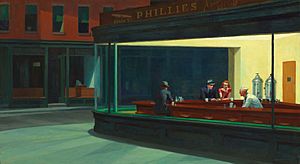
One of Hopper's most famous paintings is Nighthawks (1942). It shows a few people sitting at the counter of an all-night diner. The bright electric light inside the diner stands out against the dark night outside. The people sitting at the counter seem to be alone, even though they are together in the same place. This painting often makes people think about feelings of loneliness or isolation in city life.
Quiet Scenes in Gas
Hopper's paintings of rural New England scenes, like Gas (1940), are also very meaningful. While another artist, Norman Rockwell, showed the lively side of small-town America, Hopper often showed it with a similar feeling of quiet solitude. In Gas, you see a lonely gas station on an empty country road. The painting shows a strong contrast between the natural light of the sky and the bright artificial light from the gas station.
Hopper's Personal Life
Edward Hopper married Josephine Nivison, who was also an artist and had been a student of Robert Henri. They were very different people. Josephine was outgoing and sociable, while Edward was quiet, shy, and kept to himself. She often put her own art career second to his. She was his main model for many paintings and managed his career and interviews. They lived a quiet life in their apartment in New York City and spent their summers in South Truro on Cape Cod.
Notable Works by Edward Hopper
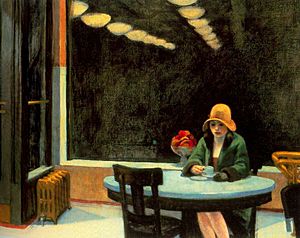
- "Night Shadows" (1921) (etching)
- House by the Railroad (1925)
- Automat (1927)
- Night Windows (1928)
- Chop Suey (1929)
- Early Sunday Morning (1930)
- The Long Leg (1935)
- House at Dusk (1935)
- Compartment C, Car 293 (1938)
- New York Movie (1939)
- Ground Swell (1939)
- Gas (1940)
- Office at Night (1940)
- Nighthawks (1942)
- Rooms for Tourists (1945)
- Rooms by the Sea (1951)
- Morning Sun (1952)
- Office in a Small City (1953)
- Excursion into Philosophy (1959)
- People in the Sun (1960)
- Sun in an Empty Room (1963)
- Chair Car (1965)
Images for kids
-
Night in the Park, etching, 1921
-
Nighthawks in the Art Institute of Chicago
See also
 In Spanish: Edward Hopper para niños
In Spanish: Edward Hopper para niños


